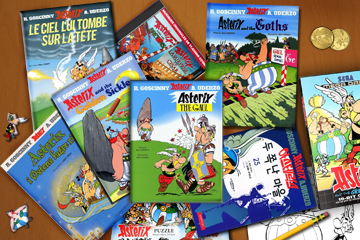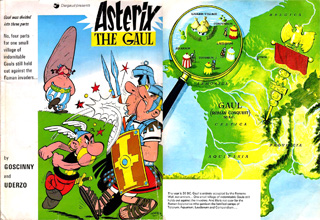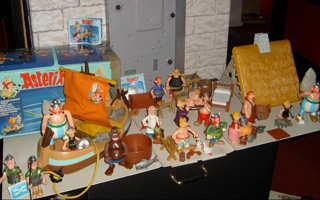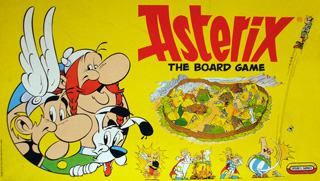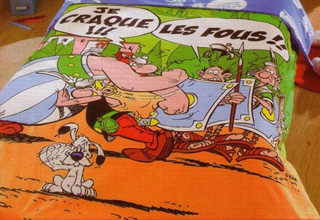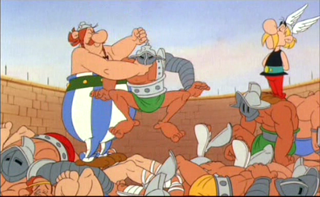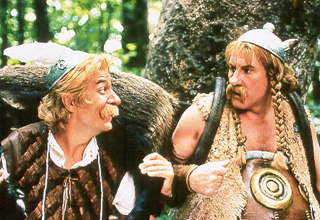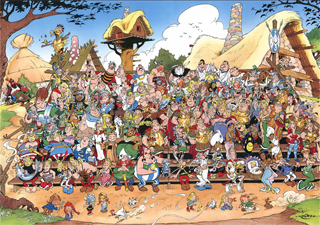
|
<<< Prior Page |
|
Page 1: |
Page 2: |
Page 3: |
Page 4: |
Page 5: |
|
Page 6: |
Page 7: |
Page 8: |
For the common American reader, the name Astérix will sound distant and unknown. It is often a question I personally ask when I travel to the continent - "Do you know about Astérix?" 8 out of 10 times, I am met by a blank stare, as if I had just cast a witch's spell with my fancy European linguistic skills. Others will have a faint memory of it from their French classes, where it was used as an example of French entertainment. It is quite surprising and even shocking for Europeans who grew up the '80s or even earlier to be faced with such a void of actual knowledge. Despite his small frame and stature, Astérix was, at one point, a juggernaut in European entertainment.
Astérix was created by René Goscinny and Albert Uderzo, two French friends who had earlier created a comic series together entitled Oumpah-pah le Peau-Rouge (Ompa-pa the Redskin). This found success in the weekly magazine Journal de Tintin, which, along with the famous Tintin shorts, would also feature shorts of other comic books , acting as a preview magazine for new properties. It was here that Astérix would come to life after being featured in another comic journal, Pilote, which among others was run by Goscinny and Uderzo. Astérix found massive success in its homeland of France, leading the team to publish a yearly comic album featuring the little Gaul. Goscinny passed away in 1977 and Uderzo would take over the franchise by himself at a slower rate, but with the same strict grip on the property as they had together, to avoid having the character be overused or mistreated.
The story takes place in a little peaceful village located in Gaul (which is now France). In the year 50 BC, Caesar and the Romans have taken nearly all of Gaul into their Roman Empire. However, the one place they cannot defeat is a tiny little village. On the outside it seems so innocent and primitive; surely the Romans could easily just walk in and defeat these Gauls? Not quite, as these Gauls have a secret which helps them resist their attacks. In this village lives Panoramix the druid, who brews a magic potion, giving those who drink it superhuman strength and near invincibility for a short period of time. Astérix, the small framed inhabitant of the village, is seen as the smartest and most courageous, so the entire village trusts him to travel out and lend aid to the people of Gaul. At Astérix's side you will always find Obélix, his lifelong best friend, who as a child fell into the magic potion and therefore has permanent superhuman strength. Despite the Romans always trying to figure out a way to defeat them, the Gauls seem nearly unthreatened by this, and will more often argue and fight amongst themselves rather than Caesar's forces.
Since 1959 and till this day, there have been 34 Astérix comic albums published. These adventures have taken him all over the world; from Egypt to India and to Norway and back to Gaul, no place has gone by without a visit from the Gallic duo. With the success of the comic books, many side projects came to life to further delve into the world of Astérix, and eventually even full length animated features were produced. It is due to the humor and social satire that it would find such massive success. Using a historical backdrop situated in a period in which most are familiar, the storytelling always introduces new characters which, while often seen as stereotypes, act as a way for the writers to put light on society's own lack of acceptance for the unknown cultures. The art style and action is appealing to young readers who enjoy the charm and bravery of a hero, while the underlying dialogue and writing is sophisticated enough so older readers can relate to real life situations, without ever compromising between the factors which make Astérix so universally loved. However, a lot of the humor is French-centric, and would require some localization before being released in other territories, but for the most part, the caricatures easily translate into other languages.
Astérix books and media have seen release in many languages and platforms.
Another big factor to its success was the diverse and colorful cast, in which everyone could find someone to relate to. Over the 34 adventures, many characters come and go, but the Gauls and Romans remain largely unchanged. The cast featured below gives you a small overview of the characters which are featured most predominently in the video games. For the sake of international clarity, this article will refer to the characters by their original French names, but their most common English names are shown in this bio in the brackets:
Regular cast of Astérix

Astérix
The small sized hero and main character. He has an unmatched sense of bravery, loyalty and justice. When there is trouble, the townspeople turn to Astérix for help. His name means "Little Star" in Greek.
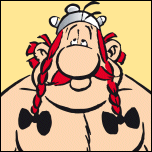
Obélix
Astérix's best friend and sidekick. He fell into the cauldron with the magic potion as a kid and as a result he is under permanent effect from it. Though not the sharpest knife in the drawer, he is amazingly kind and often saves Astérix in times of trouble. He has an unstoppable appetite. A recurring gag is that Obélix feels it's unfair he cannot even have the tiniest drop of the potion, but if he drinks it, it will have dire side effects.

Idéfix (Dogmatix)
Obélix's trusted little dog who can always be seen at his side. Idéfix always joins along on the adventures, and when he is not allowed to do so, he finds a way to follow Obélix and will often save the day. He is a tiny little mutt, but still as brave as the biggest of animals.

Panoramix (Getafix)
Panoramix the druid lives in the Gaul village and is the only one who knows the recipe for the magic potion. He acts as the elder and is a father-like figure to the villagers. The Romans are often eager to capture him to learn his secrets. While all the Gauls love to fight and will dive into brawls willingly, Panoramix is never seen engaging in any form of physicality.
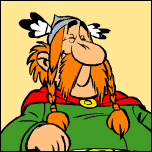
Abraracourcix (Vitalstatistix)
The chief of the village. The villagers always looks to him to make a decision, but rarely sees him as a real leader and will rather argue and fight to determine what should be done. While rather courageous and somewhat logical, he shares the fear of the other Gauls that the skies will fall down on their heads.

Assurancetourix (Cacofonix)
The village bard, Assurancetourix loves singing and playing on his signature lyre. The problem is that he has no talent for music and at the mere mention of playing a tune, the entire village will beat him up. He most often acts as comic relief, but has had times where he takes center stage.
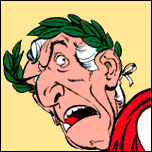
Julius Caesar
The dictator of the Roman empire and legendary historical figure. While he is most often plotting ways to conquer the last piece of Gaul, he is always portrayed as a man of true honor and class, and will never play dirty to defeat the Gauls. Astérix and Caesar have mutual respect for one another, and while on opposite sides, never directly inflict any damage on each other.

Centurion
A nameless centurion who first appeared in the cartoon movie Astérix et la surprise de César (Astérix Versus Caesar). Since then his likeness has been featured in many video games and other forms of merchandising. He hates the Gauls with passion and will do anything to stop them, and even plots of ways that he one day can take the throne from Caesar.
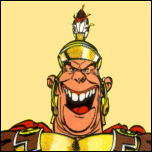
Absolumentexclus (Ignoramus)
A Centurion who appears in a number of the movies and comics. He is somewhat of a big brute with little brains, but remains very loyal to his superiors and orders.
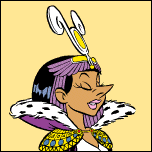
Cleopatra
The Queen of Egypt. Always noted for her beautiful nose, she controls Egypt fearlessly. Initially unsure of what to think of the Gauls, she eventually befriends and assists them whenever they might need it. She even entrusts her own son to Astérix's care eventually. Her mannerisms are inspired by Elizabeth Taylor's take in the movie Cleopatra from 1963.
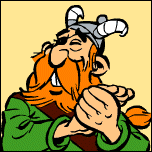
Barbe Rouge (Redbeard)
The pirate leader and captain of the fleet. He acts tough, but if he sees a single Gaul, he will fall to his feet in tears and beg for mercy. He, along with his shipmates, are always treated as simpletons for Obélix to bully around.

Falbala (Panacea)
The most beautiful girl in the Gaulish village. She often is seen as Obélix's love interest, although they never become an item. Her kisses are known to be irresistible.
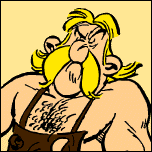
Cétautomatix (Fulliautomatix)
The village blacksmith and one of the strongest men around. He is quite short tempered, and will find himself daily fighting with Ordralfabétix, as his nearby fish stall, naturally, reeks of rotten fish.
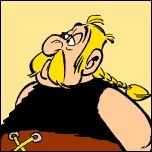
Ordralfabétix (Unhygienix)
A fish salesman who seems to only have rotten fish to sell. The smell of his fish is often what triggers the village brawls.

Agecanonix (Geriatrix)
Despite being 93 years old and having only one working leg, this old man is just as eager to get into fights as any other Gaul. He is the eldest of the villagers except for the Druid, but the other villagers see him as a demented old man. Despite his love for fighting and blatant anger issues, his wife loves him dearly and he is shown to be a great husband.
Every cast member had a rich personality to draw stories from and aid them into becoming pivotal parts of different storylines. With such a vast range of characters and adventures, it was only natural for Astérix to eventually be featured in others forms of media than just comics. Since 1967, there have been 11 Astérix movies, with 3 of them being live action adaptations. The cartoons were massive when they were released. Long time fans will often argue over the quality of the story and humor in comparison to the comics they are based on, but every person who grew up in Europe during the '70s and '80s will remember these cartoons with fond memories. While in terms of technology and production they are not on par with the offerings of Disney, their impact and popularity certainly rivaled the American animation giant at one point, especially with Les Douze Travaux d'Astérix (The Twelve Tasks of Astérix), a story written specifically for the movie and a true masterpiece of European animation.
So with the popularity of Astérix being seemingly ever growing, merchandise was coming out in all shapes and forms. Music CDs, candy, food items, bed sheets, lunch boxes, soaps, towels, action figures - you name it, Astérix had it. I even remember being able to buy small juice boxes as a kid called Astérix's Magic Potion that came in orange or apple flavors. Along with the numerous items, a theme park was also opened and still operates to this very day. Parc Astérix is located in Paris and only 20 miles away from Euro Disney. It is famous for its many roller coasters and good food. For many years it was only open during summer for limited amounts of hours, but now you can visit it during winter time as well and has remained a popular destination for children from all over Europe.
During the '80s, another form of entertainment was growing fast - video games. Astérix was relatively quick to jump on the bandwagon of having its own licensed video game, and since then has had a history as varied as the one you will find in the books and movies. Most of these games would be developed in Europe and be handled by studios and key players early in their careers before eventually working on franchises which would achieve more worldwide exposure. With over 30 games since 1982 and still growing, Astérix has become Europe's longest running video game franchise.

Astérix creators René Goscinny & Albert Uderzo
First book: Astérix le Gaulois (Astérix the Gaul)
11 Astérix movies have been made since 1967
Astérix action figure set

Parc Astérix, theme park outside of Paris
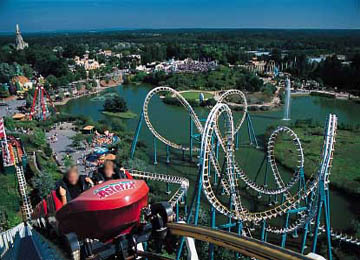
Parc Astérix sky view
Cooking with Astérix
Astérix The Board Game
Astérix bed sheets
Astérix glasses
Scene from Astérix et la surprise de César (Astérix Versus Caesar)
Astérix shampoo and soaps
Christian Clavier and Gérard Depardieu in Astérix et Obélix contre César
Astérix audio books
Astérix Pez dispensers
The cast of Astérix.
|
<<< Prior Page |
|
Page 1: |
Page 2: |
Page 3: |
Page 4: |
Page 5: |
|
Page 6: |
Page 7: |
Page 8: |
